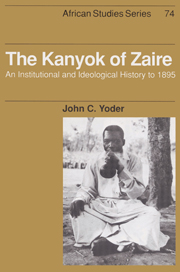Book contents
- Frontmatter
- Contents
- List of maps and figures
- Acknowledgments
- Abbreviations
- Chronology
- Introduction
- 1 Wood and wine, gardens and game
- 2 Stratification, symbols, and spirits
- 3 New legends for new leaders
- 4 Serpents and lightning
- 5 Dances, moats, and myths
- 6 Combat, classes, titles, and trade
- 7 Schisms and slaves, ghosts and guns
- 8 Assassinations, alliances, and ambushes
- APPENDIX: Methodology
- Notes
- Bibliography
- Index
- Titles in the series
4 - Serpents and lightning
Kanyok images of chiefship in the 1700s
Published online by Cambridge University Press: 29 September 2009
- Frontmatter
- Contents
- List of maps and figures
- Acknowledgments
- Abbreviations
- Chronology
- Introduction
- 1 Wood and wine, gardens and game
- 2 Stratification, symbols, and spirits
- 3 New legends for new leaders
- 4 Serpents and lightning
- 5 Dances, moats, and myths
- 6 Combat, classes, titles, and trade
- 7 Schisms and slaves, ghosts and guns
- 8 Assassinations, alliances, and ambushes
- APPENDIX: Methodology
- Notes
- Bibliography
- Index
- Titles in the series
Summary
The eighteenth-century Kanyok were increasingly drawn into the expanding Luba economic, political, and cultural orb. Of all the Kanyok leaders, the chiefs at Mulundu were the most successful in profiting from the opportunities afforded by the enlarged Luba trade and tribute system and in avoiding the dangers presented by an aggressive Luba domain. The Mulundu regime owed its success to a series of dynamic chiefs who continued to borrow Luba political ceremonies and symbols, but who also maintained an independent base of authority. In part they relied on their own personal shrewdness and strength, and in part, they drew on traditional Kanyok or Bantu theories and rituals to improve their positions.
During the seventeenth century, when they had consolidated their wealth and political control, ambitious Kanyok rulers had emphasized and exaggerated their ties to powerful and prestigious neighbors. Not only had these Kanyok chiefs sought to enter the Luba trade and tribute network, claim Luba ancestry, borrow Luba titles, and tell stories about dancing the tomboka at the court of a Luba chief, they had even argued, anachronistically, that earlier matrilineal heroes such as Citend and Mwen a Ngoi had Luba connections. By the last decades of the eighteenth century, however, economic exchanges, once welcomed as opportunities to profit from the extensive Luba tribute system, frequently were interpreted as taxation or even extortion; the ceremonies of tomboka, initially performed as indispensable rituals of investiture, were sometimes viewed as marks of denigrating subordination; and legends of Luba hunters, originally fashioned to offer prestige and independence to patrilineal big men, increasingly were discredited as instruments of cultural and ideological oppression.
- Type
- Chapter
- Information
- The Kanyok of ZaireAn Institutional and Ideological History to 1895, pp. 51 - 63Publisher: Cambridge University PressPrint publication year: 1992



